California mission records show our maternal 4th Great Grandpa Efigenio Ruiz was born in approximately 1747 in the old Spanish presidial town of El Fuerte, Sinaloa, Mexico (described in old mission records as Villa del Fuerte, Sinaloa) which is located on the River Fuerte.
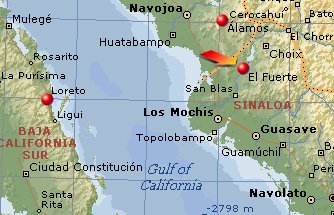 Efigenio Ruiz's birth city, El Fuerte, Sinaloa, Mx. (Click to enlarge)
Efigenio Ruiz's birth city, El Fuerte, Sinaloa, Mx. (Click to enlarge)
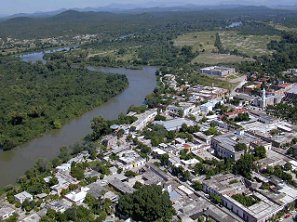 Efigenio Ruiz's birth city, El Fuerte
Efigenio Ruiz's birth city, El Fuerte
Efigenio was the son of Domingo Ruiz and Maria Josefa de Lugo.
[1] He had at least one sibling, Juan Maria Ruiz, who is listed by historian Marie Northrup
[2] as having the same parents and orginating from from Villa del El Fuerte, Sonora (not Sinaloa). El Fuerte is near the Sonora-Sinaloa border, so it is likely the boundaries may have changed. Northrup lists Efigenio separately with no mention of his parents.
There are many additional Spanish soldiers named Ruiz from El Fuerte, Sinaloa who came to Alta California and are most likely related to Efigenio. We will list them when referenced reliable sources are provided.
A Brief History of El Fuerte, Sinaloa, Mexico:
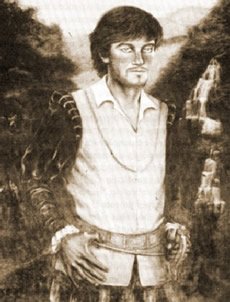 Spanish Conquistador Captain Francisco de Ibarra
Spanish Conquistador Captain Francisco de Ibarra
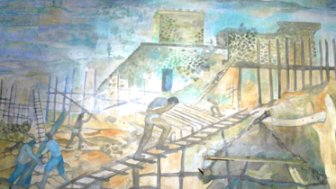 Building The Royal Presidio, El Fuerte Montesclaros
Building The Royal Presidio, El Fuerte Montesclaros
El Fuerte, Sinaloa, Mexico was founded in 1563 by the 25-year-old Spanish conquistador Captain Francisco de Ibarra, who originally named it "San Juan Bautista de Carapoa".
Destroyed by Indians, the town was rebuilt and renamed El Fuerte in 1610 after the Spanish Fort,
El Fuerte Montesclaros, which was constructed to ward off the fierce Zuaque and Tehueco Native American tribes.
El Fuerte was a major farming and commercial center and trading post on El Camino Real (the Spanish mule trail) between Guadalajara to the southeast, the mines of Alamos to the north and the Sierra Madre Occidental to the northeast.
Efigenio's Travels in Mexico:
At some point prior to 1769 Great Grandpa Efigenio moved north from El Fuerte to Alamos (also known as Los Alamos), Sonora, Mexico, a mining and religious center.
While living in Alamos in approximately 1769 Efigenio married Maria Rosa Lopez, who was also a native of El Fuerte.
[3]
Sometime between 1769-1771 Efigenio and his wife moved to the
Buenavista Presidio of the Bishopric of Arispe, Sonora, Mexico, where Efigenio was working as a soldado de cuera. Their oldest child, Maria Ursula Ruiz, was born at the Presidio in 1771, according to her 1786 Mission San Buenaventura marriage record which lists her as a national of the "
Presidio de Buenavista, Obispado de Arispe".
By 1780 Efigenio and his family were living at the Villa of San Miguel of the Bishopric of Horcasitas, Sonora, Mexico (a settlement with a military fort founded 30 years earlier) where Efigenio continued working as a soldado de cuera. While living in Villa de San Miguel, Efigenio's youngest child at the time, Jose Hilario, was born in approximately 1780.
Jose Hilario's son Ambrosio's 1805 Santa Barbara baptism record states that Hilario was a "national dela Villa de San Miguel en el Obispado de N.?". San Miguel is listed in many mission records as "San Miguel de Orcasitas".
Given the
detailed information of Jose Hilario's national origin, San Miguel is most likely his correct birthplace, although three of his chidren's mission records list his birthplace as Alamos.
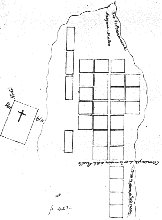 Plans for Pueblo of Los Angeles
Plans for Pueblo of Los Angeles
Harlow Map 1781, Bancroft Library (Click to enlarge)
Efigenio's Journey to Alta California
Many sources list
Efigenio Ruiz as being a
soldado de cuera[4] (leather jacket soldier) recruited for Captain Fernando de Rivera y Moncada's 1781 expedition to Alta California.
Filling in the Gap, Plans for Los Angeles and Santa Barbara:
By 1780 Alta California's western coast had three presidios, eight missions, and one pueblo, but there was still a 200 mile gap between the northern and southern missions which had no Spanish settlements.
To complete the chain of settlements, the first Spanish Governor of Alta California, Felipe de Neve, envisioned the building of the
Pueblo of Los Angeles, the
Royal Presidio of Santa Barbara, and three additional Santa Barbara Channel missions.
Governor Neve drew detailed plans for the establishment of the pueblo which was to be located along the Porciuncula River (later named Los Angeles River), four leagues northwest of the Mission San Gabriel.
The pueblo would reaffirm Spains claim over the territory, and would also help to keep Spains California military garrisons supplied and fed (whereas they otherwise would have to be supplied irregularly by ship).
A Brief History of Rivera's 1781 Expedition to Alta California:
 King Carlos III
King Carlos III
 Viceroy Croix
Viceroy Croix
Spanish King Carlos III approved the petition for Governor Neve's proposed new settlements, which had been sent through the king's personal representative, Viceroy Marquis de Croix, and Visitador General, Jose de Galvez.
In December 1779 Viceroy Marquis de Croix called upon the seasoned veteran, Captain Fernando Rivera y Moncada, to recruit, organize, and escort the settlers and soldiers needed for Governor Neve's new Alta California settlements. Rivera traveled from Loreto, Baja California to Arispe, Sonora, Mexico to confer with Croix, whose instructions to Captain Rivera included:
- Recruit 24 settlers and 59 presidial soldiers, who were heads of families;
- Recruit robust and well behaved settlers, so that they might set a good example for the natives. The families are to accompany
these recruits, and encourage the unmarried female relatives to come as well, with the intention of marrying bachelor soldiers;
- Do not to recruit in Sonora, this is an underpopulated area from which previous expeditions had drawn too many colonists;
- Purchase 1,000 head of livestock, including horses for the presidial companies and the settlers, and
- Offer incentives of money, land and livestock.
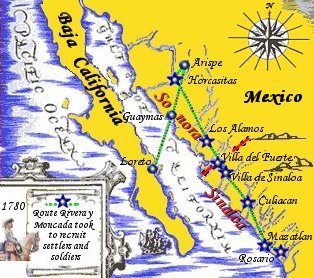 Rivera y Moncada's Recruitment Route
Rivera y Moncada's Recruitment Route
Rivera y Moncada marched from Arispe to Horcasitas to begin his recruitment of settlers in February 1780. However, even with the generous incentives offered to new colonists, he found it difficult to find promising and willing candidates.
Captain Rivera spent nine exhausting months in his search for recruits, in which he traveled to the following cities on Mexico's west coast, listed in the order visited,
1. Horcasitas
2. Alamos
3. Villa del Fuerte
4. Villa de Sinaloa
5. Culiacan
6. Mazatlan
7. Rosario.
By November 1780 Rivera was eventually able to enlist only fourteen families for Los Angeles, a little over
half of the number required (with two families deserting before reaching California). Viceroy Croix, not wanting to delay the expedition any longer,
decided to go forward with these recruits, and ordered Rivera back to the expedition's headquarters in Los Alamos to prepare to
leave for Alta California.
Once everyone had assembled in Los Alamos, they were issued supplies, mounts and clothing for the trip. Rivera then divided the
settlers and soldiers into two groups according to Viceroy Marquis de Croix instructions. Both groups were to rendezvous at
Mission San Gabriel in Alta California.
There is some disagreement among several researchers who have studied these two groups as to which families were placed in what
group, and as to the total number of people in each group.
(List of all people recruited for the RIVERA EXPEDITION)
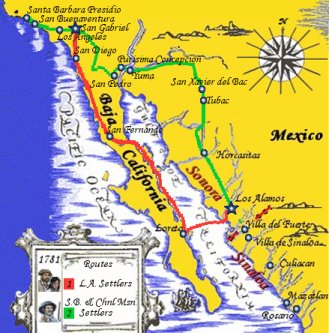 1781 Alamos to Msn. San Gabriel - Group One & Two's Routes
1781 Alamos to Msn. San Gabriel - Group One & Two's Routes
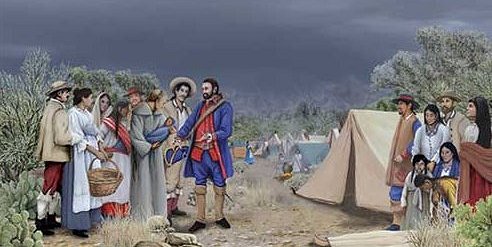 A Scenerio Typical of Rivera's 1781 Expedition
A Scenerio Typical of Rivera's 1781 Expedition
EXPEDITION'S GROUP ONE: The first group of Rivera's Expedition included the Pueblo of Los Angeles pobladores (settlers) and an escort of approximately seventeen soldiers
and their families. They were commanded by Teniente (Lieutenant) Jose Zuniga and Alferez (Ensign or 2nd Lt.) Ramon Lasso de la Vega.
-
On February 2, 1781 they left Alamos, crossed the
Gulf of California to Loreto (stayed at the Presidio 3-4 months as some members had contracted smallpox), and traveled up the
Baja California peninsula, intermittently stopping at Baja missions and San Diego before proceeding on to Mission San Gabriel.
-
On August 18, 1781 Group One arrived at Mission San Gabriel.
-
In Mission San Gabriel's First Book of Baptisms
it is written, "On 18 August 1781, Teniente Jose de Zuniga and Ramon Lasso de la Vega arrived here with eleven pobladores
with their families and seventeen soldados de cuera from Lower California via San Diego".
EXPEDITION'S GROUP TWO: Captain Rivera led the second group
from this expedition which included the Santa Barbara Presidio and the three channel missions soldiers, their families, and the 1,000 head
of livestock. Among the members of this party were Great Grandpa Efigenio, his wife, Rosa Lopez, and three children, Maria Ursula, age 10;
Jose Pedro, age 7; and Jose Hilario, age 1. (Efigenio and his family were most likely living at the Villa of San Miguel of the Bishopric
of Horcasitas, Sonora, Mexico when Efigenio was recruited as a Santa Barbara Presidial soldier.)
- In April 1781 they left Alamos and folowed the Anza Trail. They
traveled to Horcasitas, from there to Tubac Presidio, then to Mission San Xavier del Bac. They then crossed the harshest
of deserts** , whose temperatures could soar up to 120 degrees Fahrenheit.
** Route from the Spanish presidial settlements in upper Sonora to the Colorado River was called the Camino del Diablo,
the "Road of the Devil."
- In June 1781 (latter part) they stopped at the Yuma Crossing***
(the junction of the Gila and lower Colorado rivers) at Mission Puerto de Purísima Concepción located at Fort Yuma. They then journeyed
on to Mission San Pedro and from there to Msn. San Gabriel.
*** Mark Santiago's Massacre at the Yuma Crossing: Spanish Relations With the Quechans, 1779-1782
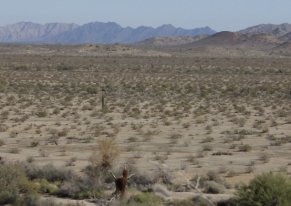 Camino del Diablo
Camino del Diablo
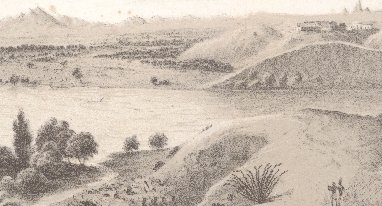 East Side of Yuma Crossing - Looking West - Mission Purisima Concepcion On Hill
East Side of Yuma Crossing - Looking West - Mission Purisima Concepcion On Hill
Captain Rivera, finding it impossible to get all of the
weakened livestock across the river, sent the majority of the party and animals ahead without him. Rivera and a few soldiers made camp near the
eastern bank of the river opposite the Mission Purisima Concepcion to allow his herd to rest and graze before continuing on to
Mission San Gabriel.
-
On July 14, 1781 Group Two arrived at Mission San Gabriel without Rivera.
-
In Mission San Gabriel's First Book of Baptisms it
is written, "On 14 July 1781, Alferez Cayetano Limon and Alferez Jose Dario Arguello under the command of Teniente Diego Gonzalez arrived
at the mission with a troop of thirty married soldiers with their families and five unmarried soldiers from Sonora via Yuma for the Santa Barbara Presidio".
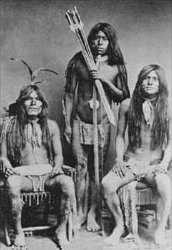 Yuma (Quechan) Indians
Yuma (Quechan) Indians
-
The fates of Captain Rivera and his soldiers that remained behind
in Yuma would not be so fortunate. Rivera provided the spark to the powder keg of brooding resentment the Yuma (Quechan) Indians already had
against the local missions and Spanish settlers.
The Spaniards had whipped some Indians and placed some stocks,
had not given the promised gifts, had taken the best of what little crop-supporting land was available, and had allowed their roving cattle to
wreck the Indian's crops. Now Rivera had allowed his livestock to ravage the mesquite trees which were vital to the Yuma's subsistence. This
incited the natives to rebel at both nearby settlements.
On July 17-18, 1781 the Indians attacked* and burned
Missions Purisima Concepcion and San Pedro, took the women and children hostage, and massacred 46 Spaniards, including the padres,
all the male settlers they could find, and Captain Rivera and his men.
Spain sent two punitive expeditions against the Yumas in
Sept.-Oct. and Dec. 1781, led by Catalonian-born Lt. Fages. However, he had not the forces to punish the rebels, and was only able to
rescue/ransom 63 captives, recover the remains of the 4 padres, and kill 25 Yumas in various skirmishes. The natives maintained control of
the Yuma Crossing, and Spain would NEVER again be able to use this land route to Alta California.
*READ Yuma pioneer Maria Ana Montielo's detailed account of
"THE YUMA MASSACRE".
Efigenio's Life in Alta California: Below is a a chronology of Great Grandfather Efigenio's life in Alta California using the following format:
Date - City - Where in City
RECORD/EVENT, and an explanation of the event.
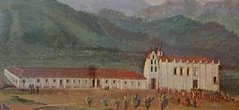 Mission San Gabriel Arcangel
Mission San Gabriel Arcangel
14 July 1781 - San Gabriel - Mission San Gabriel Arcangel
 RIVERA EXPEDITION
RIVERA EXPEDITION: Efigenio is listed as Efigenio Ruiz, an expedition member (as well as his family) by Marie E. Northrup; her reference sources included mission and garrison records, California Padrones (censuses), pioneer indexes, and other early-California-history books and records.
30 Oct 1781 - San Gabriel - Mission San Gabriel Arcangel
 GARRISON LIST
GARRISON LIST: Efigenio is listed on the roster for
Presidio and Missions of the Channel of Santa Barbara.
22 Mar 1782 - San Gabriel - Mission San Gabriel Arcangel
 MISSION CONFIRMATION RECORD
MISSION CONFIRMATION RECORD: Efigenio's first and third children, Maria Ursula Ruiz and Jose Hilario Ruiz, are confirmed.
26 Mar 1782 - San Gabriel - Mission San Gabriel Arcangel
 MISSION MARRIAGE RECORD
MISSION MARRIAGE RECORD: Efigenio and his family leave San Gabriel with "the expedition to found the new Mission of San Buenaventura and the Presidio of Santa Barbara", whose departure is recorded in the mission's
First Book of Marriages.
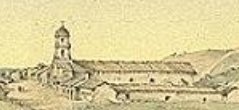 Mission San Buenaventura
Mission San Buenaventura
31 March 1782 - Santa Barbara Channel - Mission San Buenaventura
 SANTA BARBARA EXPEDITION
SANTA BARBARA EXPEDITION: Efigenio and his family are present when Mission San Buenventura is founded.
April 1782 - Santa Barbara Channel - Mission San Buenaventura
 SANTA BARBARA EXPEDITION
SANTA BARBARA EXPEDITION: Efigenio and his family leave San Buenaventura and walk on to Santa Barbara with Governor Felipe de Neve, Capitan Jose Francisco Ortega, Fr. Junipero Serra, and thirty-five other soldiers and families.
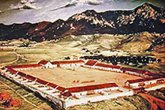 Santa Barbara Presidio
Santa Barbara Presidio
21 Apr 1782 - Santa Barbara Channel - Santa Barbara Presidio
 SANTA BARBARA EXPEDITION
SANTA BARBARA EXPEDITION: Efigenio and his family are present when the Santa Barbara Presidio is founded.
1 July 1782 - Santa Barbara Channel - Mission San Buenaventura
 GARRISON LIST
GARRISON LIST: Private Eugenio is assigned to guard the mission, attached to the Santa Barbara Presidio.
16 May 1783 - Santa Barbara Channel - Santa Barbara Presidio
 PRESIDIAL BAPTISM RECORD
PRESIDIAL BAPTISM RECORD: Efigenio's fourth child is born, a daughter, Maria Delos Dolores Dominga Ruiz, and is baptized eight days later on 24 May.
2 Jan 1784 - Santa Barbara Channel - Mission San Buenaventura
 MISSION BAPTISM RECORD
MISSION BAPTISM RECORD: Efigenio and his wife, Maria Rosa Monreal, are listed as a padrinos (godparents) for Maria Rosa Castaneda, daughter of Jose Ruiz Castaneda, a Santa Barbara Presidial soldado de cuera, and his wife, Barbara y de Isabel Callis.
28 Mar 1784 - Santa Barbara Channel - Mission San Buenaventura
 MISSION MARRIAGE RECORD
MISSION MARRIAGE RECORD: Efigenio gives a marriage testigo (testament) for the 26 Dec 1782 marriage of Jose Miguel Flores, a Santa Barbara Presidial soldado de cuera, and Maria Dela Concepcion Quintero. Efigenio was a witness at the marriage.
8 May 1784 - Santa Barbara Channel - Mission San Buenaventura
 MISSION BAPTISM RECORD
MISSION BAPTISM RECORD: Efigenio is listed as a padrino for the 15 Jan 1784 baptism of Jose Pablo Parra, the son of Jose Anto. Parra, a soldado de cuera, and Maria Isabel Talamantes.
8 Jun 1785 - Santa Barbara Channel - Mission San Buenaventura
 MISSION BAPTISM RECORD
MISSION BAPTISM RECORD: Efigenio's recently-born fifth child, a daughter, Maria Cirilia Procopia Ruiz, is baptized.
19 Jul 1786 - Santa Barbara Channel - Mission San Buenaventura
 MISSION MARRIAGE RECORD
MISSION MARRIAGE RECORD: Efigenio's first born child, 15-year-old Maria Ursula Ruiz, is married to Eugenio Rosalio Villavicencio, a Monterey Presidial soldado de cuera.
4 Apr 1788 - Santa Barbara Channel - Mission San Buenaventura
 MISSION BAPTISM RECORD
MISSION BAPTISM RECORD: Efigenio is listed as a padrino for Juan Vicente Chrisostomo Valencia's 6 May 1786 baptism.
3 May 1789 - Santa Barbara Channel - Mission San Buenaventura
 MISSION BAPTISM RECORD
MISSION BAPTISM RECORD: Efigenio's sixth child is born, a daughter, Rosa Maria Ruiz, and is baptized the next day.
31 Dec 1789 - Los Angeles - Pueblo
 PUEBLO DE LOS ANGELES
PUEBLO DE LOS ANGELES : AGREGADOS: Efigenio Ruiz.
17 Aug 1790 - Los Angeles - Pueblo
 ALTA CALIFORNIA PADRON (CENSUS)
ALTA CALIFORNIA PADRON (CENSUS): Efigenio Ruiz, espanol, 43, vaquero, from El Fuerte; married to Maria Rosa Lopez, espanola, 37; espanol children: Jose Pedro Ruiz, 16; Maria Dolores, 7; Maria Sirilda, 5; Rosa Maria, 1.
16 Jan 1791 - San Gabriel - Mission San Gabriel Arcangel
 MISSION CONFIRMATION RECORD
MISSION CONFIRMATION RECORD: Efigenio's sixth child, Rosa Maria Ruiz, is confirmed.
24 Nov 1791 - San Gabriel - Mission San Gabriel Arcangel
 MISSION BAPTISM RECORD
MISSION BAPTISM RECORD: Efigenio's seventh child, a daughter, Maria Catharina Ruiz, is born and is baptized the next day.
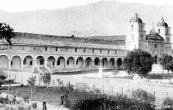 Mission Santa Barbara
Mission Santa Barbara
31 Dec 1791 - Santa Barbara Channel - Mission Santa Barbara
 MISSION CONFIRMATION RECORD
MISSION CONFIRMATION RECORD: Efigenio's fifth child, Maria Cirilia Procopia Ruiz (transcription error states her name as Maria Emelda Ruiz), is confirmed.
27 Oct 1793 - Santa Barbara Channel - Mission Santa Barbara
 MISSION CONFIRMATION RECORD
MISSION CONFIRMATION RECORD: Efigenio's seventh child, Maria Catharina Ruiz, (transcribed record states her name as Maria Catalina Ruiz, and Efigenio's name as Aigenio (Efigenio?...)), is confirmed.
29 Jan 1794 - Santa Barbara Channel - Mission Santa Barbara
 MISSION BAPTISM RECORD
MISSION BAPTISM RECORD: Efigenio's eighth child, a son, Josef Joaquin Ruiz, is baptized.
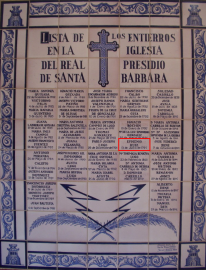 Efigenio's Memorial S.B. Presidio Chapel (Click to enlarge)
Efigenio's Memorial S.B. Presidio Chapel (Click to enlarge)
About 12 Jun 1795 - Santa Barbara Channel - Santa Barbara Presidio Chapel

 MISSION DEATH RECORD
MISSION DEATH RECORD: 48-year-old Efigenio, a resident of the Santa Barbara Presidio, dies, and is buried in the chapel on June 13, 1795.
A memorial tile dedicated to him hangs on the wall in the Santa Barbara Presidio Chapel.
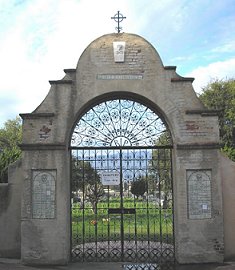 Gate to Mission San Gabriel Cemetery
Gate to Mission San Gabriel Cemetery
There is not much more on record regarding our Great Grandfather Efigenio Ruiz.
His widow, Maria Rosa Monreal Lopez, gave birth to her ninth child, a son, Josef Antonio Nicolas Ortega in Santa Barbara on Dec. 6, 1796, 18 months after Efigenio's death.
The priest notes on the child's Dec 10th Santa Barbara baptism record that according to widow Maria Rosa's confession, Vicente Ortega, single, was the father. He's listed as such on the record.
The child, however, went by the name Nicolas Ruiz, as listed in his 1818
Mission San Buenaventura marriage record.
As far as we can tell, Maria Rosa never remarried. She moved from Santa Barbara to the Los Angeles Pueblo as early as November 1797.
When Alferez Pablo Cota came to the pueblo in search of recruits for the army at that time, he recorded, "Widow of Efigenio Ruiz [Maria Rosa Lopez] She has one son in the army,
and the one that is left cares for her stock. If he is taken, she wishes him to serve in the same company as his brother."
Maria Rosa Lopez lived out the rest of her life in Los Angeles Pueblo where she died at age 75.
She was buried under the name of Rosa Maria Efigenia Lopez on September 23, 1828 at Mission San Gabriel by Padre Sanchez.
References
- ^Ontiveros, Erlinda Pertusi (1990). San Ramon Chapel Pioneers and Their California Heritage. Olive Press Publications.
- ^Northrup, Marie E. (1976) Spanish-Mexican Families of Early California: 1769-1850 Volume I. Polyanthos, Inc.
- ^Santa Barbara County Genealogical Society. Ancestors West
- ^Soldado de Cuera: Verdugo to California: A Brief History of Portola's 1769 Expedition to Occupy Alta California
















 RIVERA EXPEDITION: Efigenio is listed as Efigenio Ruiz, an expedition member (as well as his family) by Marie E. Northrup; her reference sources included mission and garrison records, California Padrones (censuses), pioneer indexes, and other early-California-history books and records.
RIVERA EXPEDITION: Efigenio is listed as Efigenio Ruiz, an expedition member (as well as his family) by Marie E. Northrup; her reference sources included mission and garrison records, California Padrones (censuses), pioneer indexes, and other early-California-history books and records.
 MISSION CONFIRMATION RECORD: Efigenio's first and third children, Maria Ursula Ruiz and Jose Hilario Ruiz, are confirmed.
MISSION CONFIRMATION RECORD: Efigenio's first and third children, Maria Ursula Ruiz and Jose Hilario Ruiz, are confirmed.


 PUEBLO DE LOS ANGELES : AGREGADOS: Efigenio Ruiz.
PUEBLO DE LOS ANGELES : AGREGADOS: Efigenio Ruiz.


 MISSION DEATH RECORD: 48-year-old Efigenio, a resident of the Santa Barbara Presidio, dies, and is buried in the chapel on June 13, 1795.
MISSION DEATH RECORD: 48-year-old Efigenio, a resident of the Santa Barbara Presidio, dies, and is buried in the chapel on June 13, 1795.
